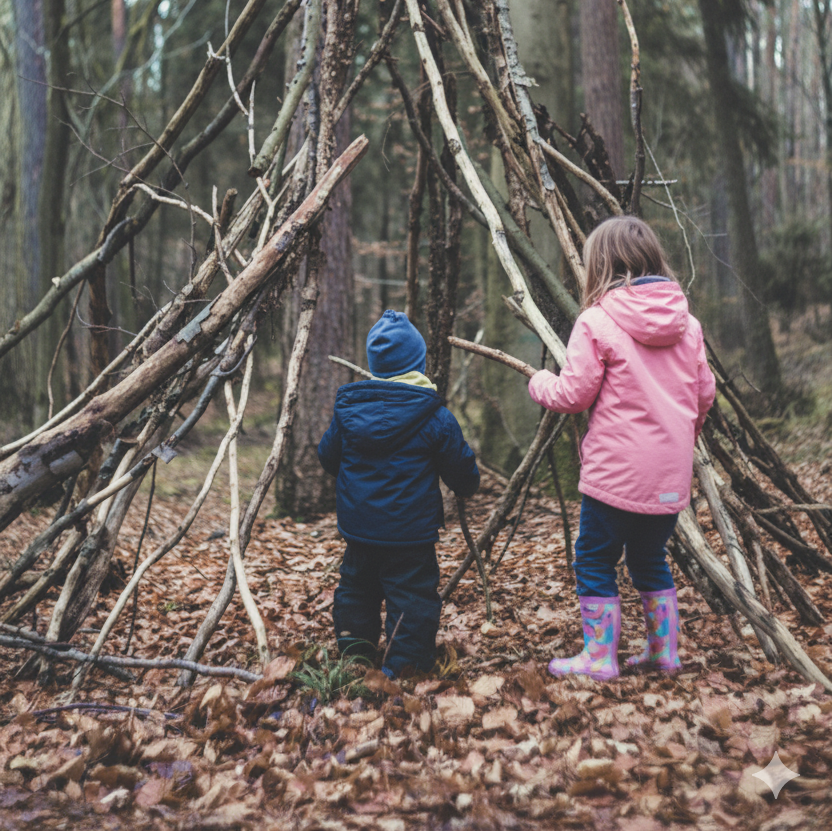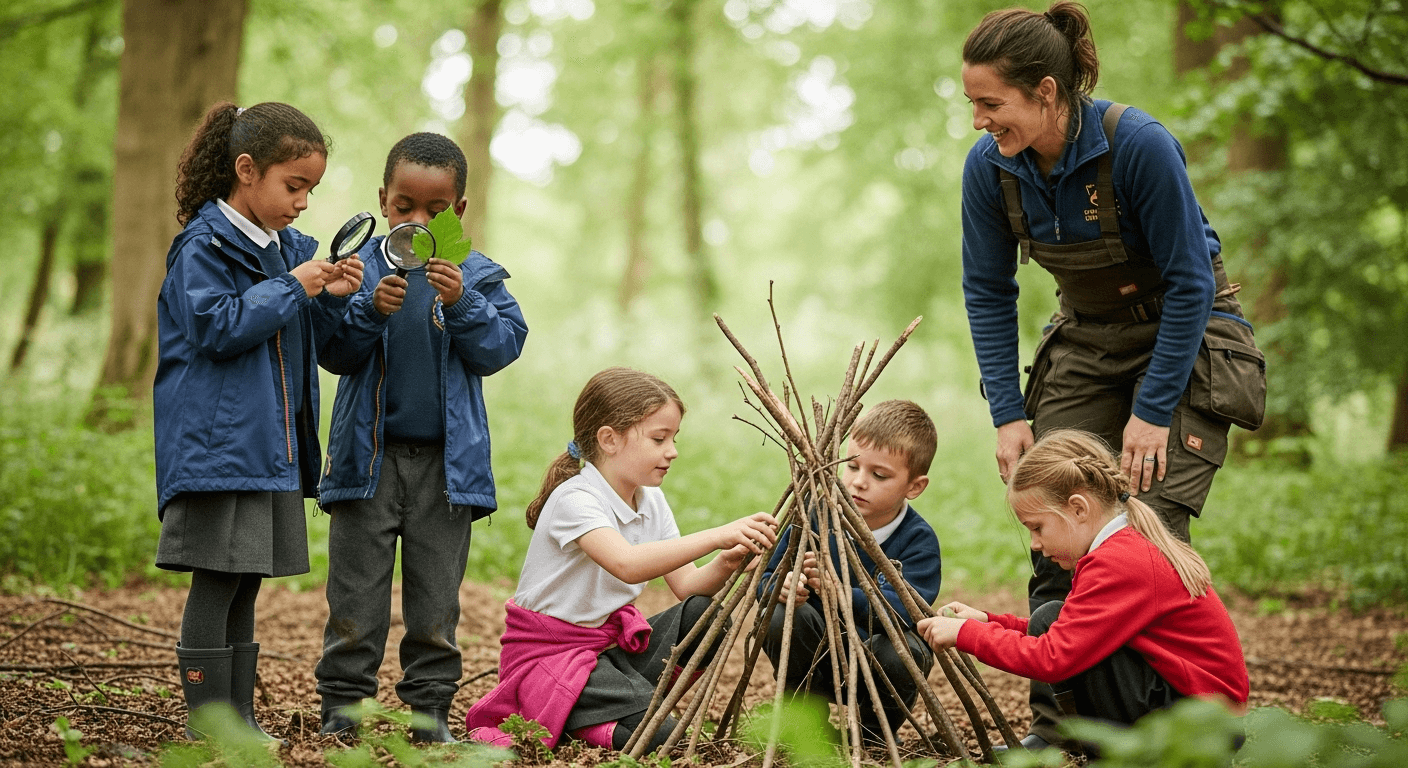· Getting Started · 6 min read
What Actually is Forest School? A Simple Guide for Curious Parents
Ever wondered what Forest School really means beyond kids playing in the woods? This simple guide explains it all for curious parents in the UK.

You’ve probably heard the term “Forest School” buzzing around. Maybe a friend’s child attends one, or you’ve seen it mentioned online. It sounds idyllic, doesn’t it? Children exploring nature, getting muddy, and learning in the fresh air. But what actually is Forest School? Is it just playing in the woods, or is there more to it? This guide offers a simple explanation for curious parents.
Many parents wonder if it’s just another term for outdoor learning. While there are similarities, and Forest School is certainly a type of outdoor learning, it has its own distinct philosophy and approach. Let’s explore what makes Forest School unique.
Forest School Definition: More Than Just a Walk in the Park
So, what is the official Forest School definition? The Forest School Association, the UK’s professional body, defines it as:
“An inspirational process, that offers ALL learners regular opportunities to achieve and develop confidence and self-esteem through hands-on learning experiences in a woodland or natural environment with trees.”
That’s a good starting point. The key things to pick out are “inspirational process,” “regular opportunities,” “confidence and self-esteem,” and “hands-on learning.” Forest School isn’t a one-off nature trail. It’s a long-term programme that allows children to continuously build on their skills and experiences.
Think of it like this:
- Regular Sessions: Children usually attend Forest School consistently over a period, whether it’s weekly, fortnightly, or in a block. This regularity is crucial. It allows children to build a connection with the environment, observe changes through the seasons, and develop a sense of ownership and belonging.
- Child-Led Learning: While activities are facilitated by trained Forest School leaders, a lot of the learning is driven by the children’s own interests and discoveries. If a child is fascinated by a particular bug, that might become the focus of their exploration.
- Play-Based: Play is fundamental. Children learn through exploring, experimenting, and imagining. Forest School provides the space and freedom for this.
- Holistic Development: It’s not just about learning facts about trees. Forest School aims to develop the whole child – their physical skills, social skills, emotional intelligence, and communication.
- Natural Environment: The setting is key. It’s typically a woodland, but can be any natural environment that allows children to connect with nature.
For parents in the UK searching for what is forest school UK, it’s helpful to know that it has a strong and growing presence here, with qualified practitioners and established principles. It’s not just a trendy idea; it’s a well-thought-out educational approach.
What Happens at Forest School? A Peek into the Woodland Classroom
You might be picturing children quietly identifying leaves. While that can happen, a Forest School session is usually much more dynamic. Forest school explained in terms of activities often includes:
- Shelter Building: Using natural materials like branches, logs, and leaves to create dens and shelters. This involves teamwork, problem-solving, and physical effort.
- Tool Use: Under close supervision, children might learn to use tools like saws, peelers (for whittling), and hand drills. This builds confidence, teaches respect for tools, and develops fine motor skills. Safety is paramount, and children are taught to handle tools responsibly.
- Fire Lighting and Cooking: Again, with strict safety measures, children can learn about fire – how to build it safely, its uses, and even cook simple snacks over it. This is a powerful experience that teaches respect for elements and basic survival skills.
- Nature Observation: Minibeast hunts, tracking animals, identifying plants and trees, and simply observing the sights, sounds, and smells of the woodland. This fosters a deep connection with the natural world.
- Creative Activities: Using natural materials for art and crafts – making leaf rubbings, creating woodland creatures from twigs and clay, or weaving with long grasses.
- Games and Imaginative Play: The woodland becomes a backdrop for all sorts of adventures, from searching for trolls to being explorers in an uncharted land.
- Risk-Taking: This is a big one. Forest School encourages children to take appropriate risks in a supported environment. This could be climbing a tree, balancing on a log, or using a new tool. Learning to assess and manage risk is a vital life skill. It helps children understand their capabilities and limitations.
The role of the Forest School leader is not to instruct in a traditional sense. They are facilitators. They observe the children, support their interests, introduce new skills when appropriate, and ensure everyone is safe and respected. They create a nurturing environment where children feel empowered to explore and learn at their own pace.
The Benefits: Why Choose Forest School?
The growing popularity of Forest School isn’t accidental. It offers a wealth of benefits that contribute significantly to a child’s development, often complementing traditional schooling. When you consider the advantages, the essence of forest school explained becomes even clearer.
Key Benefits for Your Child:
- Increased Confidence and Self-Esteem: Successfully completing a task they initially found challenging, like lighting a fire or building a sturdy den, gives children a huge sense of achievement. Being trusted with real tools and responsibilities also boosts their self-belief.
- Improved Social Skills: Many Forest School activities are collaborative. Children learn to work together, share ideas, negotiate, and resolve conflicts. They develop empathy and communication skills.
- Enhanced Physical Skills: Running, climbing, balancing, carrying, digging – Forest School is a full-body workout! It improves gross motor skills, coordination, and stamina. Fine motor skills are also developed through activities like whittling or threading leaves.
- Greater Connection to Nature: In an increasingly digital world, Forest School provides a vital opportunity for children to connect with the natural environment. This fosters a sense of wonder, respect for nature, and an understanding of their place within it. This can lead to a lifelong appreciation for the outdoors.
- Improved Mental Wellbeing: Spending time in nature is known to reduce stress and anxiety. The calm and sensory-rich environment of a woodland can be incredibly soothing and restorative for children. It provides a break from the pressures of modern life.
- Curiosity and Creativity: The natural world is full of interesting things to discover. Forest School encourages children to ask questions, investigate, and use their imaginations. A stick can become a wand, a sword, or a fishing rod.
- Resilience and Problem-Solving: Things don’t always go to plan in the woods. A den might collapse, or a fire might not light easily. Children learn to persevere, adapt, and find solutions to problems. This builds resilience.
- Language and Communication: Children naturally talk about what they are doing and seeing. They learn new vocabulary related to nature and tools, and they practise explaining their ideas and listening to others.
The emphasis on outdoor learning within the Forest School framework allows children to learn in a multi-sensory way. They don’t just read about a tree; they can touch its bark, smell its leaves, see the insects that live on it, and hear the wind rustling through its branches. This makes learning more memorable and meaningful.
If you’re considering Forest School, try to visit a session if possible, or talk to the leaders. Ask about their ethos, their training, and how they structure their days. See if it feels like the right fit for your child. It offers a wonderfully enriching experience, allowing children to grow, learn, and, just as importantly, have a lot of fun in the process. It’s about fostering a love for learning and the outdoors that can last a lifetime.



